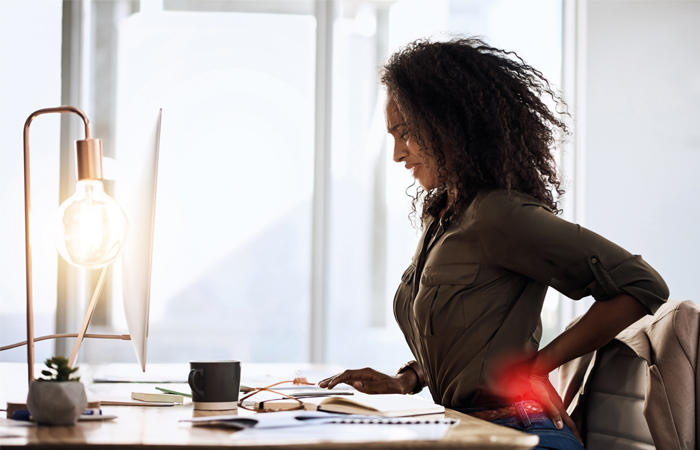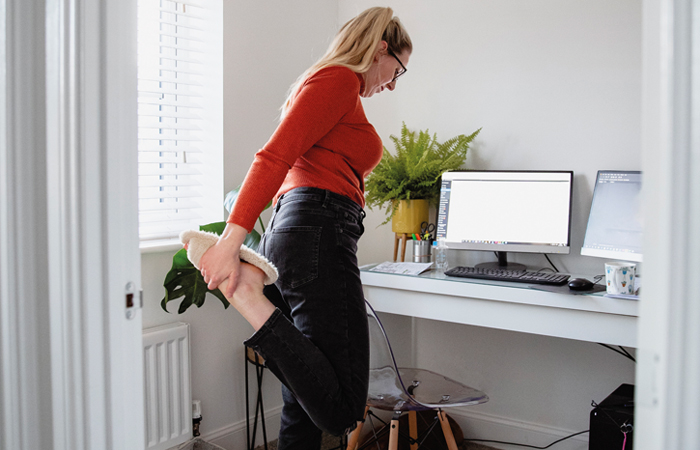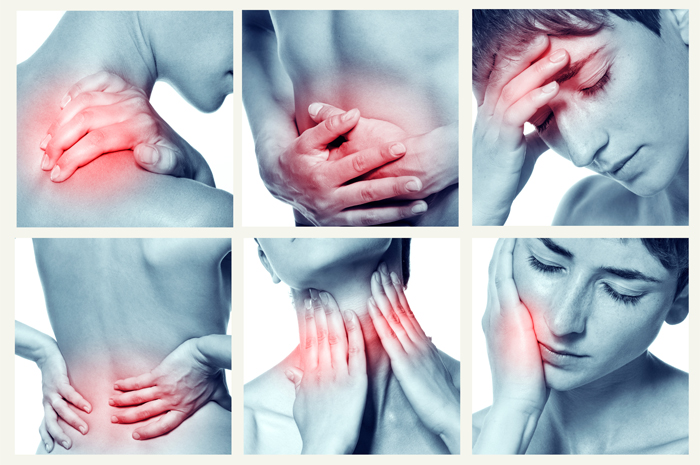Straight talking
In OTC Category Reviews
Follow this topic
Bookmark
Record learning outcomes
Most people will experience some form of musculoskeletal pain in their lifetime, but there are plenty of ways to avoid and ease it, and community pharmacy can help
The Covid-19 pandemic has seen most people confined to their homes to help limit its spread, but restrictions on their ability to move around and exercise, coupled with some people working from home, could be having a detrimental effect on their bodies.

With sedentary lifestyles becoming the norm even before the pandemic, plenty of research points to a rise in people reporting problems with musculoskeletal (MSK) pain. According to a recent report from the charity Versus Arthritis, three in 10 adults suffer with MSK pain, and the British Pain Society says almost 10 million Britons suffer pain almost daily, resulting in a major impact on their quality of life and more days off work.
The Versus Arthritis report says depression is four times more common among people in persistent pain compared to those without pain and around 63 per cent of working-age adults with an MSK condition are in work compared to 82 per cent of people with no health condition.
Sitting ducks
According to GP Dr Dawn Harper, there is a growing body of evidence highlighting the link between sedentary lifestyles and back pain. She says this is “likely to continue to rise as a result of prolonged periods of inactivity, combined with an ageing and increasingly obese population”.
Research from Mentholatum’s ‘Mind Your Back’ campaign shows that three out of five respondents (57 per cent) sit down for four or more hours of their working day, and remain seated for another two to four hours once work is over. In addition, the study identifies bad posture as a trigger for muscular pain for two out of three adults (68 per cent). What’s more, the nation’s so-called ‘walk-shy’ lifestyles have left two out of five people (39 per cent) experiencing MSK problems at least once a week, over a third (35 per cent) of adults experience more back pain than they did a year ago, and two out of three adults (68 per cent) have experienced pain as a result of their posture.
Is ibuprofen safe?
A review by the Commission on Human Medicines (CHM) – an expert body that advises the Government – claims there is not enough evidence to show a link between using ibuprofen and contracting or worsening of Covid-19, and therefore ibuprofen is safe to take if suffering from the virus.
The CHM Expert Working Group on coronavirus also says patients can take paracetamol or ibuprofen when self-medicating for symptoms of Covid-19, such as fever and headache, and should follow current NHS advice if they have any questions or if symptoms get worse. See the Pharmacy Scenario on Covid-19 NICE guidelines for more and keep up to date via the Government website.
Back to basics
Dr Michael Flynn is a medical doctor and chairman of Nova Medical Solutions Limited, and has spent much of his professional life developing and evaluating new pharmaceutical products and medical devices. He says bad posture can be a key component of back pain, but it can be addressed. “Slouching with a bent back while working is not a natural posture,” he explains. “But it is not difficult to maintain a straight back, provided the chair is the right height so that the feet can be tucked under the chair from time to time, which enables one to easily sit upright with a straight back and minimum effort.”
Experts in ergonomics advise anyone whose job involves sitting for long periods to take a one- or two-minute break to stand up and move around every 20 to 30 minutes. Another approach is for desk-based workers to break up their day with standing-based work, or switching to a sit-stand desk, where available.
Maintaining good posture is also important for people with arthritis, as it puts less strain on joints, according to Versus Arthritis, and this can help the body feel more relaxed.
However, Emma Davies, advanced pharmacist practitioner in pain management at Cwm Taf Morgannwg University Health Board, says it’s inactivity more than posture that plays a role in MSK pain. “Actually, posture is not thought to be particularly connected to, for example, back pain”, she says. “It’s a myth that organisations such as the Chartered Society of Physiotherapy (CSP) are trying to dispel”.
Because being inactive results in deconditioning – where muscles become less active, tire quickly and lose mass and strength – Emma says if you already have pain and are then inactive, “it often results in movement becoming increasingly painful as you are forcing deconditioned muscles, and so on, to move”.
For people with very restricted movement or particular concerns that certain movements are more painful than they think they should be, Emma’s advice is to see a physiotherapist for professional advice on how to improve strength and fitness. “If they believe that posture is an issue, then they will advise appropriately and in the context of the individual,” she says. “That said, things like yoga and pilates can be helpful for everyone, in terms of improving strength and flexibility, and over time, that might lead to gentle changes in posture as general conditioning improves.”
The study identifies bad posture as a trigger for muscular pain for two out of three adults
Analgesic advice
Now, more so than usual, community pharmacies are one of the only available healthcare settings that people can access for face-to-face advice. This gives pharmacy teams a great opportunity to help customers dealing with MSK pain.
Oral painkillers are one of the first choices for managing and preventing pain. “If people have pain and it isn’t due to a known underlying condition or illness such as flu or coronavirus then simple analgesia might be helpful,” explains Emma. “Non-steroidal anti-inflammatories (NSAIDs) are generally first line, but paracetamol can be trialled for people who are unable to use NSAIDs due to other conditions or medicines.”
However, she stresses that customers have to be made aware that the reason to take analgesics of any sort is to try to reduce the intensity of pain enough to allow them to continue to with daily life. “So, if someone takes the analgesics and it doesn’t allow them to do more – for example to continue to undertake activity or to increase the amount of activity each day or week – then it is probably not worth continuing to take the medicines,” she says.
Of course if an individual’s pain persists beyond a few days, they should be advised to talk to their GP.
Paracetamol shortages
Panic buying in the run-up to lockdown led to shortages of paracetamol in many pharmacies and retail outlets across the nation. Pharmacy teams may still find that customers have concerns about accessing it, and those who have paracetamol on prescription may also be worried about supply.
Emma Davies, advanced pharmacist practitioner in pain management at Cwm Taf Morgannwg University Health Board, says if someone has had paracetamol on prescription for an extended period – for example, more than three months – it might be worth having a trial of reducing or stopping it to make sure it is actually helpful. “Ideally this should be the case with all analgesics,” she says, adding that pharmacy teams can reassure customer that “paracetamol doesn’t tend to cause withdrawal in most people, although sudden cessation of any medicine can cause changes in symptoms or cause new symptoms to emerge which might be due to withdrawal”.
However, Emma stresses that “it is absolutely not appropriate to be asking for prescriptions of paracetamol for ‘just in case’ – it should only be used by people who benefit from regular use for chronic conditions”.
Topical pain relief
“Topical products can be a valuable option when people are suffering muscle and joint pain, but are unable or unwilling to take oral medication,” says Kaye Mackay, senior brand manager and new product development at Mentholatum. “The non-medicated patches and roll-on gels and lotions available can give effective relief without compromising other medication.”
For suitable customers, topical analgesics have a number of advantages: they deliver targeted, effective relief at the point of pain; because they do not enter the bloodstream they do not pass through the internal organs and may be associated with fewer gastric side effects; and there are many drug-free options on the topicals fixture, ideal for patients who are concerned about taking drug-based medication.
Topical NSAIDs are also a short-term alternative for people for whom oral NSAIDs might be a higher risk – for example, due to renal function, heart failure, or the use of other medications such as ACE inhibitors. However, they are not without risk and the same cautions apply as for oral NSAIDs, particularly in terms of overuse.
Topical products can be a valuable option when people are suffering muscle and joint pain
Hot and cold therapy
Another way to help manage pain symptoms is with hot and cold therapy. As a general rule of thumb, ice helps acute injuries or pain, along with inflammation and swelling, and heat eases muscle pain or stiffness.
“We instinctively seek something warming or cooling when we experience muscle pain,” says postural alignment specialist Jan Keller. “Heat may work by improving circulation and relaxing muscles, while cold may numb the pain, decrease swelling, constrict blood vessels and block nerve impulses to the joint.”
Emma’s advice is to try it and see. “If it works for you and helps keep you active, then carry on. If it doesn’t help, don’t do it,” she says.
Alternative treatments
The British Pain Society says many complementary therapies have also been found to be useful as part of an overall pain management regime, stating: “Hypnotherapy, including self-hypnosis, can be used as part of a relaxation technique, [and] acupuncture and acupressure may be helpful in the management of chronic headaches, migraine and muscle pain syndromes.”
However, the organisation warns that “there are a large number of other therapies which are being offered at a variety of costs. Many of them have not been proven to be of any benefit, and the majority of these have not been subjected to clinical trials to show whether or not there is any benefit. It is also important to tell your doctor if you are using any form of herbal medicines as these may interact with other prescribed drugs [and] remember that when using natural remedies, natural does not mean safe.”
The key, therefore, is advising all customers to do their research and get expert help where necessary.

Self care measures
Self care is vital for effective pain management, whether in the short or long term, so it makes sense to provide self care advice with every sale of an analgesic product for body pain.
Although historically doctors recommended bed rest for back pain, Dr Harper says the current guidelines are clear: “Getting mobile as quickly as possible, and keeping on the move, is the best way to relieve and prevent problems.”
Indeed, Dr Flynn says some MSK conditions can sometimes be avoided or mitigated by attention to lifestyle, in particular eating a healthy diet and taking regular exercise. “Keeping physically active may reduce back and joint pain by 25 per cent, and hip fractures and falls by approximately 75 per cent,” he says. “Related to this is the fact that seven out of 10 people with long-term musculoskeletal conditions are overweight and particularly prone to osteoarthritis of the knee and back pain.”
Dr Flynn says an easy regular exercise is brisk walking or gentle jogging for 30 minutes each day – although he advises paying “special attention when jogging to have good shoes and avoid uneven surfaces to avoid knee damage”. During self-isolation, “if jogging around the sitting room, special care is needed at the corners to avoid falling over and defeating the objective”, he adds.
As exercise stimulates the body’s natural painkillers – endorphins – to create a feeling of achievement and vitality, Emma says a good tip is for individuals to find an activity or activities that they enjoy. “Making sure that the activity you choose is something you can do, can be fitted around other things in life that you need, and [is something] you enjoy so you stick with it is really important,” Emma explains. “Sometimes, you might not feel that something makes a big difference to the pain itself but if [it] gives you some pleasure and improves quality of life, it is more likely that over time, the pain will take a less prominent role in your day-to-day activity.”
Common questions about different types of pain
Musculoskeletal pain isn’t the only type of pain affecting the nation: a whole host of issues can cause discomfort. So what do the experts recommend?

Q: I’ve recently taken up running, but keep getting muscle strains. Should I rest, or take painkillers and carry on?
A: Sprains and strains are usually a result of overdoing physical activity. Most can be treated with self care such as the PRICE technique of protection, rest, ice (using cold packs), compression and elevation, and should improve within six to eight weeks – although severe muscle strains may take longer.
“Non-steroidal anti-inflammatory drugs (NSAIDs) are generally recommended, but paracetamol may be helpful if someone can’t have an NSAID, although topical NSAIDs might be a better initial choice, applied only to the area affected,” says Emma Davies, advanced pharmacist practitioner in pain management at Cwm Taf Morgannwg University Health Board.
Q: Since I’ve been working at home during lockdown, I’ve noticed I’m getting more headaches than I used to. What could be the cause?
A: Most headaches go away on their own and are not a sign of something serious. They can accompany cold and flu, and bad posture and stress can also have an effect. If someone is sitting at a makeshift or unfamiliar workstation at home, and things are getting on top of them and causing stress – which is understandable right now – that will not help.
Basic analgesics might be helpful for short-term relief, but Emma warns that “paracetamol is associated with medication overuse headache, although some people say it’s the only thing that works. Opioids are not recommended as they are also linked to overuse headache. Both headache and migraine benefit from tempering of any precipitating factors, and stress, caffeine and the methyl bromines found in chocolate, red wine and so on, are advised to be avoided. Regular exercise, relaxation and meditation have also been touted as helpful.”
Q: I struggle with period pain for a couple of days every month, but paracetamol doesn’t seem to work for me, and I’m concerned about taking ibuprofen at the moment. What else might help?
A: Studies have shown paracetamol does not reduce pain as effectively as ibuprofen or aspirin, but ibuprofen and aspirin are unsuitable for those with asthma or stomach, kidney or liver problems. If ordinary painkillers are ineffective, a GP may prescribe a stronger painkiller containing naproxen or codeine, but there are certainly other things can be tried at home. Having a warm bath, or putting a heat pad or hot water bottle (in a cover) on the lower abdomen may help, as can light, circular massage and relaxation techniques such as yoga or Pilates. A transcutaneous electronic nerve stimulation (TENS) machine, which delivers a mild electrical current to the lower abdomen to help reduce pain, could be used. If women experience periods that are irregular, heavier or more painful than usual, they should talk to a GP.
Q: I felt like I had water stuck in my ear after a shower last week and now I’ve developed earache. How can I ease it?
A: Earache or ear pain is common, particularly in young children. Usually only caused by a minor infection, it tends to clear up in a few days without treatment, however paracetamol or ibuprofen can be used to treat the pain, if desired.
“People sometimes find cold or warm packs helpful to apply for some relief, but if there is any discharge from the ear, then seek immediate medical attention,” Emma says.
Over-the-counter eardrops should not be used if the eardrum has perforated, or to treat an ear infection.
Q: I’ve had toothache for a couple of days, but my dentist is not open at the moment. What should I do?
A: Although routine appointments are not currently being offered, dentists should be providing a triage service via phone for those in pain, or be able to refer them to a local Urgent Dental Care hub, so customers should be advised to give them a call.
While waiting for an appointment, Dr Nigel Carter, chief executive of the Oral Health Foundation, says: “A combination of paracetamol and ibuprofen can be effective for short-term pain relief, assuming these are not contraindicated by medical history or allergies”. He warns that “topical remedies such as tooth tincture are ineffective and can sometimes do more harm than good and so should not be recommended”.
Q: We’ve all got a bit of a sore throat in our house, but I don’t want to use up our sparse supply of paracetamol on everyone. What else can we try?
A: Most sore throats can easily be treated at home, normally getting better within a week. Ibuprofen or paracetamol can help. Paracetamol is better for children and people who can’t take ibuprofen. Adults can gargle with a homemade mouthwash of warm, salty water, although this is not recommended for children. Medicated lozenges and sprays may also help, as can eating cool foods such as ice lollies. It is time to get further advice from a pharmacist, GP or NHS 111 if symptoms persist after a week. If anyone has difficulty breathing or swallowing, they should go to A&E or call 999.
